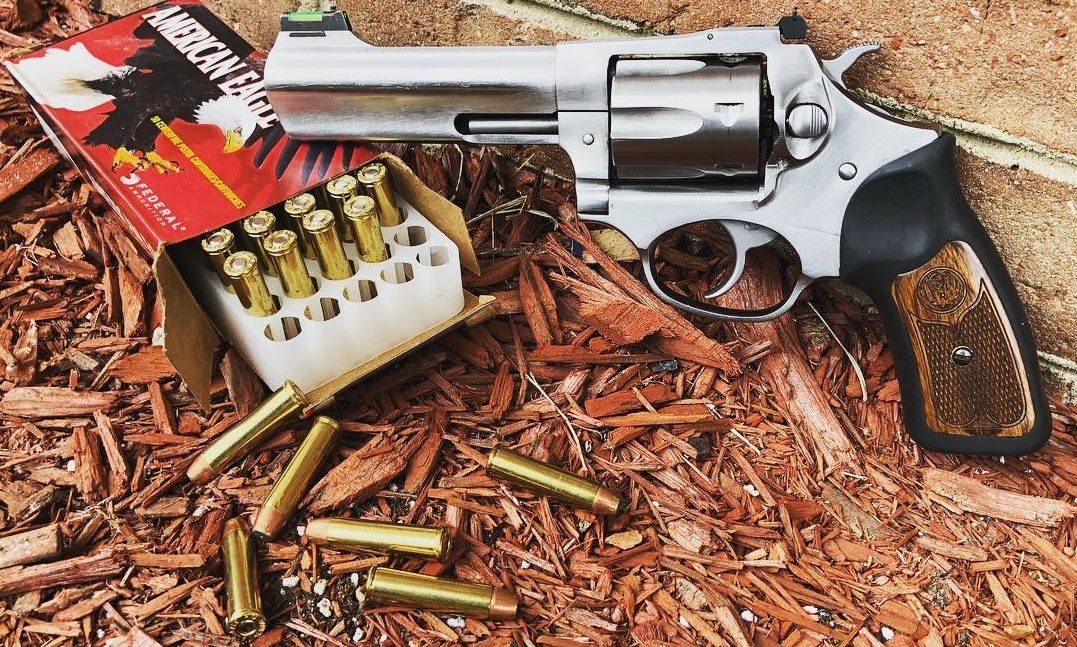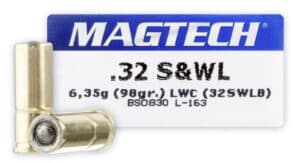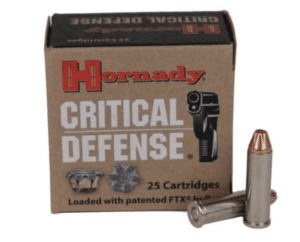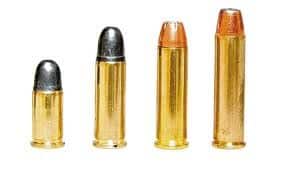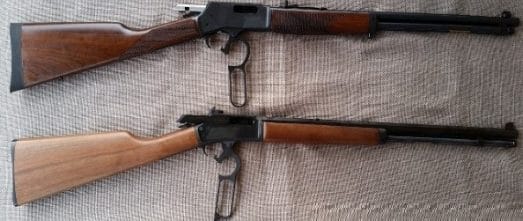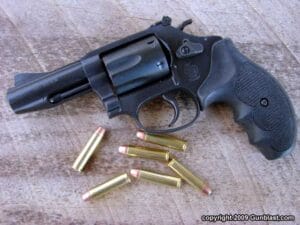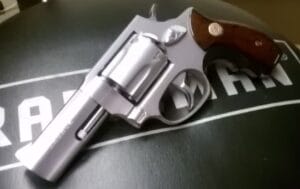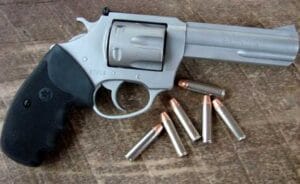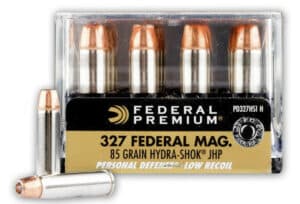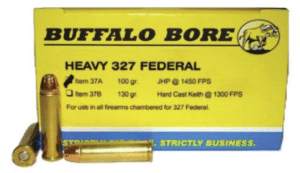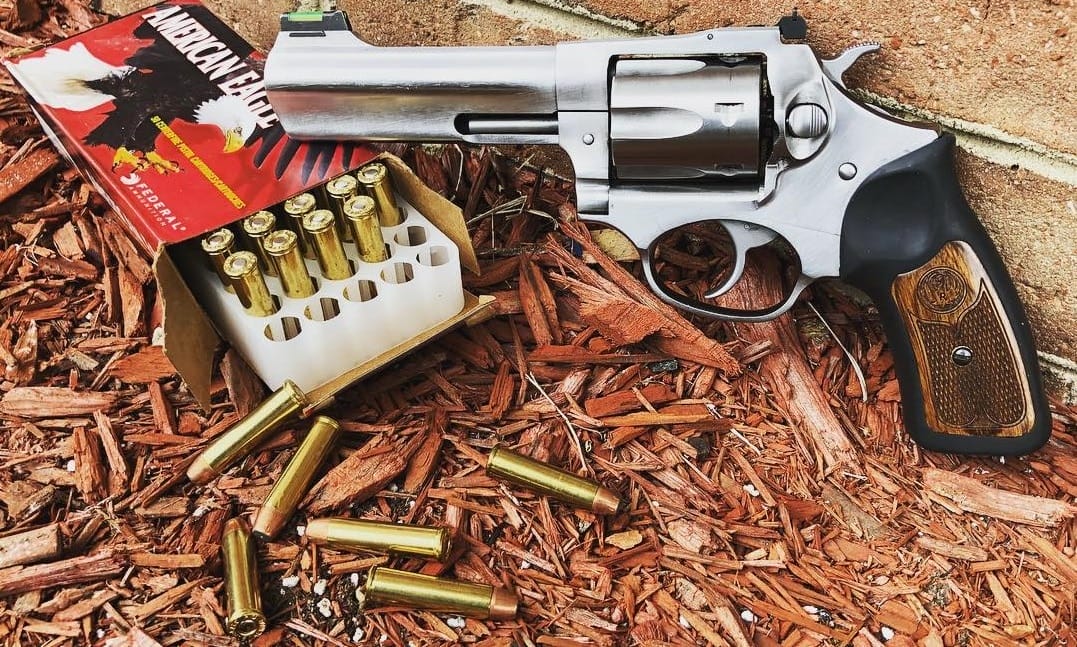
Before we dive into the merits of the .327 Federal Magnum and how it measures up to the .357, I’d like to lament a bit about the 357.
My History With the .357
It was like ages ago when I first heard of the .357 Magnum. Back when I was a kid I’d watch The Lone Ranger with my grandfather, and growing up I’d also see movies like The Silence of the Lambs, Police Academy 2, Rolling Thunder, etc. which would really make me want a .357 Magnum revolver one day.
When I was 10 years old, my father bought himself a used S&W 686 — back then I didn’t really care too much about firearm brands and models and the calibers they’re chambered for.
All I really knew about that gun was that it’s bigger than any of his other handguns and the rounds it’s loaded with are longer and thinner compared to his other handguns’ cartridges. Years later I would do research and find out why some cartridges are longer compared to others, but that wouldn’t be after a few more years.
My First Love of the .357
After finishing college and getting a job, I was able to save enough to buy myself a NIB Taurus 689, and that’s when I really started falling in love with the .357 Magnum.
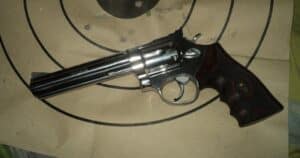
I read all the books and online articles about it that I could find and realized that there is a reason why after being designed and developed by the legendary Elmer Keith some 84 years ago, even with the advent of modern autoloaders and rimless cartridges, it was, is, and will remain to be one of the best options for self-defense.
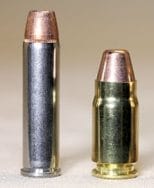
A testament to the .357 Magnum’s great track record as an effective man-stopper is the fact that there have been a few handgun cartridges developed to copy its ballistic performance. We’ve all heard of the saying “imitation is the sincerest form of flattery”. Some cartridges that quickly come to mind are the .357 SIG, the more recent 960 Rowland, and the .327 Federal Magnum, among others.
Personally, being a wheelgun type of guy, I don’t think any of these newer autoloader .357 Magnum knockoffs could ever replace the old but venerable handgun cartridge they attempt to copy.
.357 Sig and 960 Rowland
I did a write-up on the .357 SIG (why I think it will never catch on). Also, I did a fair amount of research on the 960 Rowland (but being only released just a few years ago, there isn’t enough data to write a good piece on it). I have a pretty good idea what these cartridges can do.
These two semi-auto handgun cartridges were developed to mimic the .357 Magnum’s ballistic performance to a certain extent, but both share a common weakness: limited variation in bullet weights. It’s because of the fact that being autoloader cartridges, they have to adhere to a certain standard in a cartridge’s overall length and chamber pressure.
Revolvers are made for Heavier Bullets
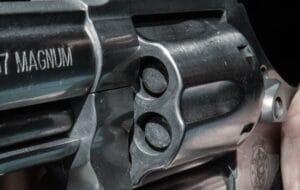
A revolver, by virtue of its multiple-chamber cylinder, can use heavier bullets with higher pressures for a number of reasons, among them being each chamber of its cylinder is separate from the barrel, and most revolvers’ cylinder is designed and machined to accommodate longer bullets. This isn’t an autoloader vs. revolver article though, so we won’t get too much into this topic.
Is the .327 Federal Magnum Smaller Weaker Version of .357?
No, the .327 Federal Magnum is not a smaller or weaker version of the .357. The .327 Federal Magnum is a relatively new cartridge introduced in 2007, and is slightly more powerful than the .357 Magnum.
Now I’ve been hearing about the .327 Federal Magnum for less than a decade now. I know it’s another magnum revolver cartridge (technically it’s a super magnum cartridge class — more on this later). But I’ve always had the impression that it’s just a smaller and weaker version of the .357 Magnum.
Lately, I’ve been doing research on it to see if it can be a viable alternative to the .357 Magnum. And boy oh boy, I think I’m about to have a love affair with it.
If you’re interested in getting a revolver chambered for the .327 Federal Magnum and you need more info to make a decision, or you’re just curious as to why it exists in the first place, read on.
Get Great Guns and Ammo Deals!
The History of the .327 Federal Magnum
To have a complete understanding of how the cartridge came about and what purpose it serves, we’ll have to dig deep into the roots of this .32-caliber super magnum.
In 1878, UMC (Union Metallic Cartridge) designed and developed the .32 S&W, a rimmed cartridge which, by today’s standards, has an awfully unimpressive ballistic performance. The design called for an 85-grain bullet measuring 0.312 inch in diameter seated in a case 0.61-inch long with a 0.375-inch diameter. It was intended for small pocket revolvers manufactured by Smith and Wesson.
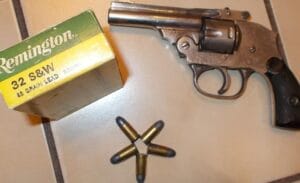
The .32 S&W Short
Also commonly known as the .32 S&W Short (not to be confused with the .32 Short Colt), this cartridge was made for weak-framed top-break pocket-size revolvers, which meant that it couldn’t be loaded to higher pressures if the manufacturer wanted (otherwise the weapon chambering it could break). It would only offer a velocity at the muzzle of around 705 feet per second, achieving less than 100 foot-pounds of force.
Thus, the .32 S&W would only be suitable for point-blank distance self-defense situations. It was rivaled by other weak point-blank-range cartridges like the .25 ACP, the .32 ACP (which is a wee bit more powerful), the .22 Short and Long, and the .22 Long Rifle.
What Caliber Was Used to Assassinate McKinley?
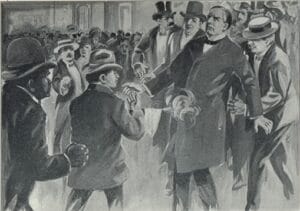
The assassin of President William McKinley used a .32 caliber revolver (Iver Johnson Safety Automatic) to shoot him on September 6, 1901, in Buffalo, New York at the Pan-American Exposition. The shooting occurred inside the Temple of Music on the Exposition grounds.
What’s notable about this little cartridge is the fact that it was used in the assassination of US President William McKinley in 1901. Leon Czolgosz, the assassin, shot the president two times in the abdomen. It wasn’t the bullets the killed William McKinley though, but the infection those two shots caused. He died because of gangrene eight days after being shot.
Before the turn of that century, Smith and Wesson introduced their Hand Ejector model chambered for the .32 S&W Long (not to be confused with the .32 Long Colt), a new cartridge based on the .32 S&W Short. You can find used models of the S&W Hand Ejector on Guns.com
The .32 S&W Long
The .32 S&W Long uses the same 0.312-inch diameter bullet but seated in a 0.92-inch case, around 50% longer than its parent cartridge case which meant that it wouldn’t chamber in any of the small pocket revolvers (the .32 S&W Short would chamber in .32 S&W Long revolvers though).
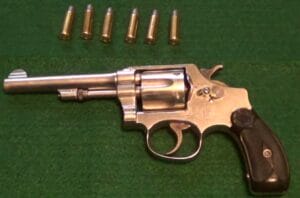
Even with its slightly longer case giving room for more powder, the .32 S&W Long’s ballistic performance was nothing to write home about. It used bullets that weighed around the same (~85 grains), which was only propelled to a maximum of 725 feet per second, resulting in a muzzle energy gain of only around 10% (~110 foot-pounds of force compared to the .32 S&W Short’s less than 100 foot-pounds of force).
With the introduction of the .38 Special, the rimmed revolver cartridge that gave birth to the .357 Magnum and to this day still enjoys widespread use all over the world with its good ballistic performance (it uses a heavier 158-grain .355-caliber bullet propelled to 950 feet per second amounting to ~300 foot-pounds of force), both the .32 S&W Short and the .32 S&W Long faded into near obscurity.
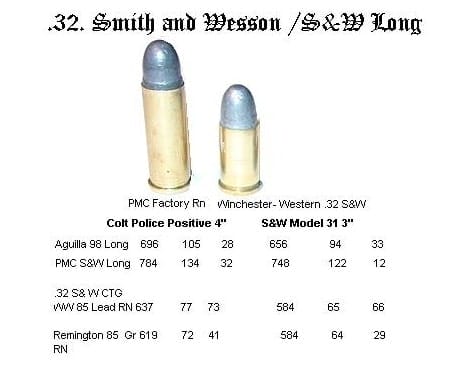
Today, even with some ammo manufacturers (e.g. Remington and Magtech, to name a few) still producing these two cartridges, existing firearms chambered solely for both can only be seen in museums.
Magtech 32 S&W Long
These .32 S&Ws from Magtech are easy to load and eject smoothly.
The .32 H&R Magnum: A Prelude to a Super Magnum
More than eight decades after the .32 S&W Long came out, Federal Premium Ammunition had a joint venture with Harrington & Richardson, a subsidiary of the Remington Outdoor Company. The two companies had the goal of developing and producing a more powerful .32-caliber revolver cartridge. In 1982, the design was completed and two years later, it was introduced as the .32 H&R Magnum.
The idea was to lengthen the .32 S&W Long’s case and load it with more powder for better ballistic performance. What the companies came up with was a magnum cartridge able to push a same-size (.312-inch diameter) but heavier (up to 100 grains) bullet to velocities of more than 1,200 feet per second, resulting in a gain of more than 200% in muzzle energy (more than 300 foot-pounds of force).
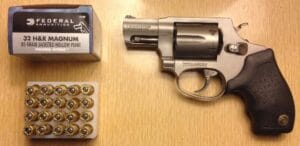
.32 H&R Equal to .38?
The gains in ballistic performance effectively put the .32 H&R Magnum in the same ballistics weight class as the .38 Special, but with less felt recoil and less muzzle rise. This makes this .32-caliber cartridge suitable for self-defense and larger (up to coyote-size) varmint hunting.
Also, because the .32 H&R Magnum is a smaller diameter cartridge, small-frame revolvers that typically only hold five .38 Special rounds in the cylinder can be made to hold six .32 H&R Magnum rounds. That’s 20% more ammo in the cylinder without having to sacrifice ballistic performance.
Are .32 H&R and .32 Short and Long Interchangeable?
No, they are not interchangeable. The .32 H&R Magnum and .32 Short and Long Colt cartridges are not interchangeable. The .32 H&R is a longer case, with a larger diameter than the .32 Short and Long Colt. The .32 H&R Magnum also operates at higher pressures than the .32 Short and Long Colt, so it is not safe to fire .32 H&R Magnum rounds in a firearm designed for .32 Short and Long Colt.
.32 H&R Ammo for Sale
The only downside to the .32 H&R is the higher cost of ammo. Because it never really became as popular as the .38 Special or the .380 ACP, ammo availability tends to be an issue. Lower demand means lower supply, and the few who are really committed to this cartridge have to put up with a higher per-round price. The only way around this issue is to hand-load. Needless to say, only a few ever really liked it.
Pushing the limits of .32-caliber Revolvers
The concept of .32 caliber cartridges for small-frame revolvers’ use just refuses to die. In 2007, Federal Premium Ammunition again had a joint venture, this time with another well-renowned firearms company, Sturm, Ruger & Co. (or just Ruger, as we enthusiasts like to call them).
The objective was to create an even more powerful .32-caliber revolver cartridge. It would have to be designed around Ruger’s snub-nose revolver platform: the solidly-built SP101.
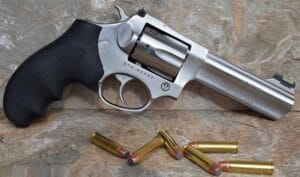
A year after the design of the cartridge was completed, the more powerful offspring of the .32 H&R Magnum was born. It was christened the .327 Federal Magnum (which, in my opinion, can also be called .32 Super Magnum because it is a super magnum, i.e. a magnum version of another magnum).
.327 Federal Magnum Early On
The .327 Federal Magnum was met with negative criticism by most revolver enthusiasts when it was released, but 10 years later it has become extremely popular among revolver enthusiasts, particularly those who prefer small-frame revolvers over any other revolver size or any semi-auto handgun. And there’s a reason for this.
.327 Federal Magnum Ballistics
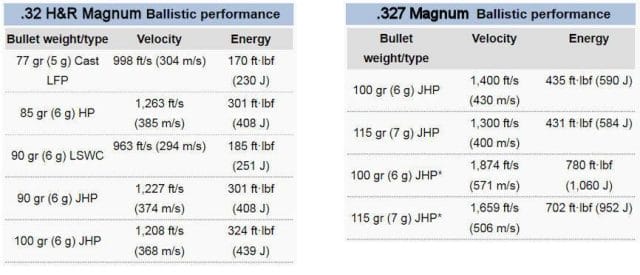
The .327 Federal Magnum’s ballistic performance is impressive, to say the least. It uses the same exact bullet diameter and case diameter as its progenitor cartridges, but its case is 0.125 inches longer than the .327 H&R Magnum’s, greatly strengthened thanks to advancements in modern metallurgy and heat treatment.
This allows for the .327 Federal Magnum’s case to handle more pressure, exceeding even that of the .357 Magnum’s. For comparison, the .32 H&R Magnum’s case has a SAAMI rating of only up to 21,000 CUP. The .357 Magnum’s case has a significantly higher SAAMI rating of a maximum of 35,000 CUP.
.327 Federal Magnum Cartridge Specs
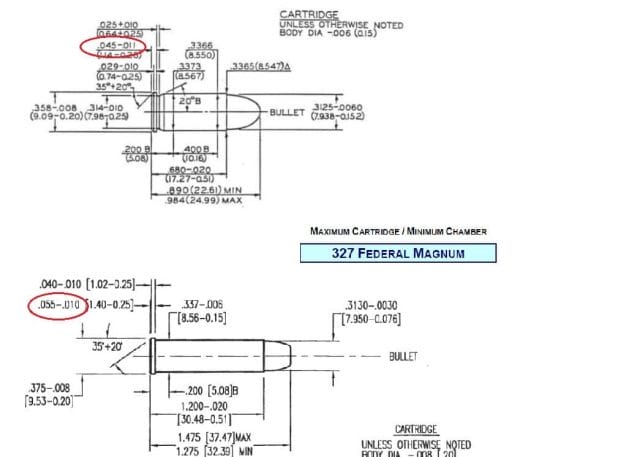
The .327 Federal Magnum’s case has an astounding SAAMI rating of 45,000 PSI, which is more than double the pressure rating of its parent cartridge the .32 H&R Magnum’s, and 28% higher than the maximum SAAMI pressure rating the .357 Magnum’s case can withstand.
This super-high pressure rating means the cartridge can be loaded with more powder to propel bullets much heavier than those its ancestor, the .32 S&W Short, used (older 85-grain bullets vs. modern bullets weighing anywhere from 100 to even 130 grains) at velocities reaching north of 1,600 feet per second out of a snub-nose revolver.
.327 Federal Magnum Muzzle Energy
Depending on the bullet weight, powder charge and velocity, out of a 3-1/16-inch barrel, hot .327 Federal Magnum loads can produce muzzle energies that can go as high up as ~600 foot-pounds of force, rivaling that of some of the warmer .357 Magnum loads but with less recoil and muzzle flip out of a snub-nose revolver. This makes the cartridge a great option for concealed carry and home defense.
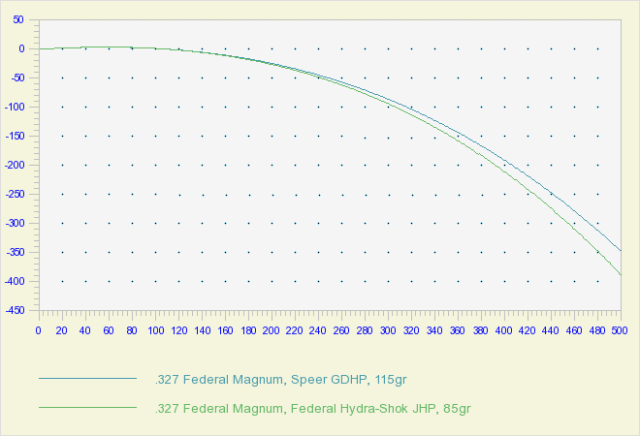
And notwithstanding the fact that it was designed primarily as a snub-nose revolver cartridge, some of the hottest .327 Federal Magnum loads that use hard cast lead bullets in a 20-inch barrel rifle should be able to take up to medium-size game (i.e. any non-dangerous animal not weighing over 350 pounds) at distances of up to 100 yards, as the chart above shows.
Whether or not it’s legal though depends on your state’s hunting laws. So you might want to do a bit of research on the matter first.
.327 Federal Magnum Cons
Of course, power comes with a price (more on ammo prices below). A less-than-desirable side effect of the .327 Federal Magnum’s impressive ballistic performance is its loud noise and blinding muzzle flash (especially during night time shooting), two things commonly associated with its bigger magnum revolver cartridge cousins.
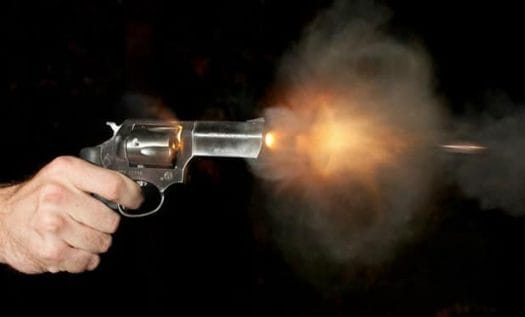
.327 Federal Magnum Versatility
Another good thing about the .327 Federal Magnum is, as with the H&R Magnum’s advantage over the .38 Special, typical small-frame revolvers chambered for the .357 Magnum can only hold up to five rounds in the cylinder, but small-frame revolvers chambered for the .327 Federal Magnum can hold up to six rounds, which translates to a 20% advantage in ammo carrying capacity.
In addition, while revolvers chambered for the .357 Magnum can shoot both the .357 Magnum and the .38 Special, revolvers chambered for the .327 Federal Magnum can shoot the .327 Federal Magnum, the .32 H&R Magnum, the .32 S&W Long and the .32 S&W Short.
How Many Calibers Can a .327 Federal Magnum Revolver Shoot?
Some people even shoot the .32 ACP in their SP101 which chambers just fine because the .32 ACP is semi-rimmed. This makes any .327 Federal Magnum revolver a multi-caliber platform able to shoot five different calibers — kind of similar to the Medusa M47.
While there’s absolutely no reason to shoot all those weaker .32-caliber cartridges in a revolver chambered for a much modern and significantly more potent cartridge, it’s always good to have options, e.g. in situations where ammo shortage is an issue, or if there’s an abundance of brass for weaker .32-caliber cartridges and the shooter doesn’t mind reloading (though these would not really be practical for any purpose outside of target shooting and plinking).
.327 Federal Magnum Firearms
Currently, there are only two firearms manufacturers in the US that are building guns chambered for the .327 Federal Magnum. These are Ruger (which shouldn’t come as a surprise — they co-designed and co-developed the cartridge with Federal), and just late last year, Henry Arms.
Ruger manufactures six different revolver models chambered for the .327 Federal Magnum:
Ruger .327 Federal Magnum Revolvers
- The original SP101 which originally chambered the first production .327 Federal Magnum cartridges, model number 5784, a 6-shot stainless steel snub-nose revolver with a 3-inch barrel and has fixed rear sight and black front sight.
- The newer SP101, model number 5773, also a 6-shot stainless steel revolver with a longer 4.2-inch barrel. This one has adjustable rear sight and fiber optic front sight.
- The Ruger LCR model number 5452, a light-weight six-shot, snub-nose, double-action only (DAO) revolver with a monolithic frame made from 400 series stainless steel. It has fixed U-notch rear sights and black front sights, a barrel length of 1.87 inches, and weighs in at only 17 ounces.
- The newer Ruger LCRx model number 5462, another light-weight, six shot, snub-nose revolver also with the monolithic frame made from 400 series stainless steel. It is practically the same as the other LCR except it has its hammer exposed so it can also be fired in single action.
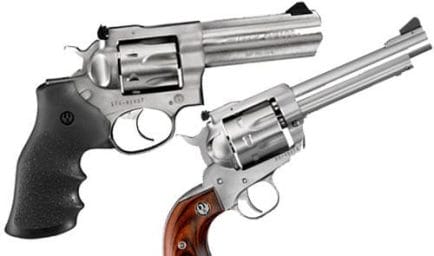
The other two are medium-frame revolvers: a GP100 stainless steel with a 4.20-inch barrel and seven shots in the cylinder, and a Blackhawk which is available in stainless steel finish, has a 5.5-inch barrel and with eight shots in the cylinder. These revolvers kind of defeat the purpose of the cartridge in my opinion but if you’re interested, you can always call their Ruger’s Sales hotline at (336) 949-5200.
Just late last year, Henry started production of their Big Boy line of rifles chambered for the first time in .327 Federal Magnum:
Henry Big Boy .327 Federal Magnum Rifles
- The Big Boy Classic model number H006M327, a lever-action rifle with a 20-inch octagonal barrel and can hold 10 rounds in its tube mag. It is SASS-approved.
- The Big Boy Carbine which, oddly, has the same model number H006MR327, also a lever-action carbine with a 16.5-inch octagonal barrel and can hold seven rounds in its tube mag.
- The Big Boy Steel, available in both rifle and carbine configurations, with again the same model number H012M327. Both come in round barrels with the rifle having a 20-inch barrel and a 10-round tube mag, while the carbine has a 16.5-inch barrel and a 7-round tube mag. Both are slightly cheaper than their octagonal round counterparts.
Can .327 Federal Magnum Rifles Shoot Multiple Calibers?
No, .327 Federal Magnum rifles will only shoot .327 Federal Magnum ammunition.
As a side note, unlike the revolvers chambered for the .327 Federal Magnum that can shoot five different 32-caliber cartridges, these Henry Rifles can only shoot two: the cartridge they’re chambered for, and the .32 H&R Magnum.
Other .327 Federal Magnum Revolvers For Sale
There are several manufacturers that made revolvers chambered in .327 Federal Magnum. You can still find them for sale if you know where to look
Smith & Wesson 632
Smith and Wesson used to manufacture a 6-shot J-frame revolver with a 3-inch barrel called the S&W 632, but they’ve stopped the production of these revolvers for a while.
Taurus .327 Revolver
Taurus also had a few different 6-shot small-frame revolvers chambered for the .327 Federal Magnum, among them a 2-inch barrel model called the Taurus 327, but they’re currently not in production.
Charter Arms .327 Federal Magnum Revolvers
Lastly, Charter Arms used to manufacture a few different revolvers chambered in .327 Federal Magnum under their Patriot product line. These were in varying barrel lengths (2.2 inches, 4 inches, and 6 inches), all had six-shot cylinders and all were in matte stainless steel finish.
But like Smith & Wesson and Taurus, Charter Arms don’t make these revolvers anymore. Info on these aren’t even available on their website. If you’re interested, use the link above to see if guns.com have any used available.
.327 Federal Magnum Ammo Availability: The One Major Drawback
Unfortunately, after 10 years of being introduced, the .327 Federal Magnum hasn’t really caught on in terms of popularity, which could be the reason why only a few companies these days manufacture ammo for this awesome cartridge.
If you could find some in your local LGS, they usually sell for around $20 to $35 for a box of 20. It doesn’t make a lot of sense when you can purchase .357 Magnum ammo cheaper.
.327 Federal Magnum Ammo Picks
Here are few brands we like and find available sometimes:
Federal Premium .327 Federal Magnum Ammo
We find this ammo to have very little flash and recoil is low with a heavy frame revolver.
Buffalo Bore .327 Federal Magnum Ammo
For hunting, Buffalo Bore offers a super hot load using 130-grain hard cast Keith-style bullets with velocities of up to 1,300 feet per second out of a 3-inch barrel. It retails for $26.49 for a box of 20, or $1.32 per round. It is a bit on the pricey side but if you can bag a whitetail with a single round, it will be more than worth it.
Reloading Your Own .327 Federal Magnum Ammo
If your budget doesn’t allow it, you can still enjoy shooting this cartridge by reloading your own ammo. Shooting Times has info on how to reload the .327 Federal Magnum, you can read through their blog if you want to know more. Additionally, here’s a fine write-up by Brian Pearce, a writer for Rifle Magazine, with info on load development if you want to come up with your own custom loads.
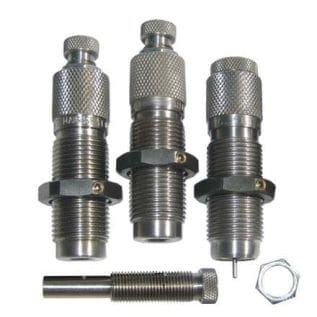
But if you’re in a hurry and you already have .327 Federal Magnum brass and dies, you can use 100-grain Hornady XTP bullets and CCI Small Pistol #500 primer as they’re a little thicker compared to Federal Primers which will allow them to handle more pressure.
CFE Pistol charge weight for .327 Federal Magnum starts at 5.9 grains and can go up to 7.0 grains if you’re shooting your reloads in a snub-nose revolver. Or you can start with 12.5 grains of Accurate No. 9 if you’re shooting them in a rifle.
.327 Federal Magnum – Conclusion
The .327 Federal Magnum will never be as good as the .357 Magnum, but it doesn’t have to be. It’s a great alternative — a smaller diameter cartridge that offers entry- to mid-level .357 Magnum ballistic performance with less recoil.
And the best thing about it is it allows for more shots in the cylinder, practically making any 5-shot small-frame revolver work just like 6-shot a medium-frame revolver.
If you prefer to carry a 6-shot magnum revolver over a subcompact semi-auto but you’re finding it difficult because most medium frames are too big to conceal and too heavy to lug around all day, an SP101 or an LCR chambered in the .327 Federal Magnum might be the best CCW piece for you.
Sadly, as with other not-so-popular handgun cartridges, the .327 Federal Magnum struggles in the ammo availability department. If you’re going to enjoy shooting this fine caliber, you will really need to get into reloading for the time being. As it is, there’s just no way to get around this issue.
Banking on Henry Arms to Boost .327 Federal Magnum Popularity
As for me, I really hope that with Henry Arms recently entering the .32-caliber rifle manufacturing arena. Interest in the .327 Federal Magnum will be invigorated. (I’m looking at your LEVERevolution loads, Hornady — make some for this caliber already!).
The .327 Federal Magnum is a great little cartridge. It can do most everything it’s bigger .357-caliber brother does, but at a smaller footprint. It deserves nothing less than the same popularity handgun calibers in its weight class enjoy.
